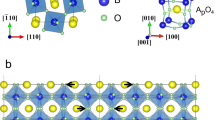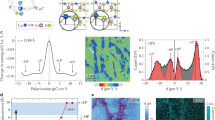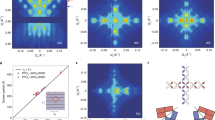Abstract
Ferroelectric thin films and superlattices are currently the subject of intensive research1,2 because of the interest they raise for technological applications and also because their properties are of fundamental scientific importance3,4,5. Ferroelectric superlattices6 allow the tuning of the ferroelectric properties while maintaining perfect crystal structure and a coherent strain, even throughout relatively thick samples. This tuning is achieved in practice by adjusting both the strain7,8,9,10, to enhance the polarization, and the composition, to interpolate between the properties of the combined compounds11,12,13,14,15. Here we show that superlattices with very short periods possess a new form of interface coupling, based on rotational distortions, which gives rise to ‘improper’ ferroelectricity. These observations suggest an approach, based on interface engineering, to produce artificial materials with unique properties. By considering ferroelectric/paraelectric PbTiO3/SrTiO3 multilayers, we first show from first principles that the ground-state of the system is not purely ferroelectric but also primarily involves antiferrodistortive rotations of the oxygen atoms in a way compatible with improper ferroelectricity. We then demonstrate experimentally that, in contrast to pure PbTiO3 and SrTiO3 compounds, the multilayer system indeed behaves like a prototypical improper ferroelectric and exhibits a very large dielectric constant of εr ≈ 600, which is also fairly temperature-independent. This behaviour, of practical interest for technological applications16, is distinct from that of normal ferroelectrics, for which the dielectric constant is typically large but strongly evolves around the phase transition temperature and also differs from that of previously known improper ferroelectrics that exhibit a temperature-independent but small dielectric constant only.
This is a preview of subscription content, access via your institution
Access options
Subscribe to this journal
Receive 51 print issues and online access
$199.00 per year
only $3.90 per issue
Buy this article
- Purchase on Springer Link
- Instant access to full article PDF
Prices may be subject to local taxes which are calculated during checkout



Similar content being viewed by others
References
Ahn, C. H., Rabe, K. M. & Triscone, J.-M. Ferroelectricity at the nanoscale: local polarization in oxide thin films and heterostructures. Science 303, 488–491 (2004)
Dawber, M., Rabe, K. M. & Scott, J. F. Physics of thin-film ferroelectric oxides. Rev. Mod. Phys. 77, 1083–1130 (2005)
Junquera, J. & Ghosez Critical thickness for ferroelectricity in perovskite ultrathin films. Nature 422, 506–509 (2003)
Fong, D. D. et al. Ferroelectricity in ultrathin perovskite films. Science 304, 1650–1653 (2004)
Lichtensteiger, C., Triscone, J.-M., Junquera, J. & Ghosez Ferroelectricity and tetragonality in ultrathin PbTiO3 films. Phys. Rev. Lett. 94, 047603 (2005)
Rijnders, G. & Blank, D. H. A. Build your own superlattice. Nature 433, 369–370 (2005)
Pertsev, N. A., Zembilgotov, A. G. & Tagantsev, A. K. Effect of mechanical boundary conditions on phase diagrams of epitaxial ferroelectric thin films. Phys. Rev. Lett. 80, 1988–1991 (1998)
Diéguez, O., Rabe, K. M. & Vanderbilt, D. First-principles study of epitaxial strain in perovskites. Phys. Rev. B 72, 144101 (2005)
Choi, K. J. et al. Enhancement of ferroelectricity in strained BaTiO3 thin films. Science 306, 1005–1009 (2004)
Haeni, J. H. et al. Room-temperature ferroelectricity in strained SrTiO3 . Nature 430, 758–761 (2004)
Neaton, J. & Rabe, K. M. Theory of polarization enhancement in epitaxial BaTiO3/SrTiO3 superlattices. Appl. Phys. Lett. 82, 1586–1588 (2003)
Dawber, M. et al. Unusual behavior of ferroelectric polarization in PbTiO3/SrTiO3 superlattices. Phys. Rev. Lett. 95, 177601 (2005)
Lee, H. N., Christen, H. N., Chrisholm, M. F., Rouleau, C. M. & Lowndes, D. H. Strong polarization enhancement in asymmetric three-component ferroelectric superlattices. Nature 433, 395–399 (2005)
Nakhmanson, S. M., Rabe, K. M. & Vanderbilt, D. Polarization enhancement in two- and three-component ferroelectric superlattices. Appl. Phys. Lett. 87, 102906 (2005)
Dawber, M. et al. Tailoring the properties of artificially layered ferroelectric superlattices. Adv. Mater. 19, 4153–4159 (2007)
Kingon, A. I., Maria, J. P. & Streiffer, S. K. Alternative dielectrics to silicon dioxide for memory and logic devices. Nature 406, 1032–1038 (2000)
Ghosez, Cockayne, E., Waghmare, U. V. & Rabe, K. M. Comparative study of the dynamical properties of BaTiO3, PbTiO3 and PbZrO3 . Phys. Rev. B 60, 836–843 (1999)
Munkholm, A. et al. Antiferrodistortive reconstruction of the PbTiO3(001) surface. Phys. Rev. Lett. 88, 016101 (2002)
Bungaro, C. & Rabe, K. M. Coexistence of antiferrodistortive and ferroelectric distortions at the PbTiO3 (001) surface. Phys. Rev. B 71, 035420 (2005)
Zhong, W. & Vanderbilt, D. Competing structural instabilities in cubic perovskites. Phys. Rev. Lett. 74, 2587–2590 (1995)
Pertsev, N. A., Tagantsev, A. K. & Setter, N. Phase transitions and strain-induced ferroelectricity in SrTiO3 epitaxial thin films. Phys. Rev. B 61, R825–R828 (2000)
Lin, C.-H., Huang, C.-M. & Guo, G. Y. Systematic ab initio study of the phase diagram of epitaxially strained SrTiO3 . J. Appl. Phys. 100, 084104 (2006)
Vasudevarao, A. et al. Multiferroic domain dynamics in strained strontium titanate. Phys. Rev. Lett. 97, 257602 (2006)
Gonze, X. et al. First-principles computation of material properties: the ABINIT software project. Computat. Mater. Sci. 25, 478–492 (2002)
Miller, S. C. & Love, W. F. Tables of Irreductible Representations of Space Groups and Co-Representations of Magnetic Space Groups (Pruett, Boulder, 1967)
Glazer, A. M. The classification of tilted octahedra in perovskites. Acta Crystallogr. B 28, 3384–3392 (1972)
Levanyuk, A. P. & Sannikov, D. G. Improper ferroelectrics. Uspekhi Fizicheskikh Nauk 112, 561–589 (1974)
Holakovski, J. A new type of ferroelectric phase transition. Phys. Status Solidi B 56, 615–619 (1973)
Eerenstein, W., Mathur, N. D. & Scott, J. F. Multiferroic and magnetoelectric materials. Nature 442, 759–765 (2006)
Fennie, C. J. & Rabe, K. M. Ferroelectric transition in YMnO3 from first principles. Phys. Rev. B 72, 100103(R) (2005)
Martin, R. M. Electronic Structure: Basic Theory and Practical Methods (Cambridge Univ. Press, Cambridge, 2004)
Teter, M. P. Additional condition for transferability in pseudopotentials. Phys. Rev. B 48, 5031–5041 (1993)
Gonze, X. & Lee, C. Dynamical matrices, Born effective charges, dielectric permittivity tensors, and interatomic force constants from density-functional perturbation theory. Phys. Rev. B 55, 10355–10368 (1997)
King-Smith, R. D. & Vanderbilt, D. Theory of polarization of crystalline solids. Phys. Rev. B 47, 1651–1654 (1993)
Monkhorst, H. J. & Pack, J. D. Special points for Brillouin-zone integrations. Phys. Rev. B 13, 5188–5192 (1976)
Acknowledgements
P.G. thanks A. P. Levanyuk for discussions concerning improper ferroelectrics. We thank R. Černý for help with X-ray diffraction. This work was supported by the VolkswagenStiftung, the European Network of Excellence FAME, the European STREP MaCoMuFi, the Swiss National Science Foundation through the “National Center of Competence in Research Materials with Novel Electronic Properties—MaNEP” and Division II, and ESF(THIOX).
Author information
Authors and Affiliations
Corresponding authors
Supplementary information
Supplementary information
The file contains Supplementary Notes illustrated with Supplementary Table S1 and Supplementary Figures S1-S2. (PDF 508 kb)
Rights and permissions
About this article
Cite this article
Bousquet, E., Dawber, M., Stucki, N. et al. Improper ferroelectricity in perovskite oxide artificial superlattices. Nature 452, 732–736 (2008). https://doi.org/10.1038/nature06817
Received:
Accepted:
Issue Date:
DOI: https://doi.org/10.1038/nature06817
This article is cited by
-
Direct observation of strong surface reconstruction in partially reduced nickelate films
Nature Communications (2024)
-
Tunable ferroelectricity in oxygen-deficient perovskites with Grenier structure
npj Computational Materials (2023)
-
Sliding ferroelectricity in van der Waals layered γ-InSe semiconductor
Nature Communications (2023)
-
A high-temperature double perovskite molecule-based antiferroelectric with excellent anti-breakdown capacity for energy storage
Nature Communications (2023)
-
Solution epitaxy of polarization-gradient ferroelectric oxide films with colossal photovoltaic current
Nature Communications (2023)
Comments
By submitting a comment you agree to abide by our Terms and Community Guidelines. If you find something abusive or that does not comply with our terms or guidelines please flag it as inappropriate.



